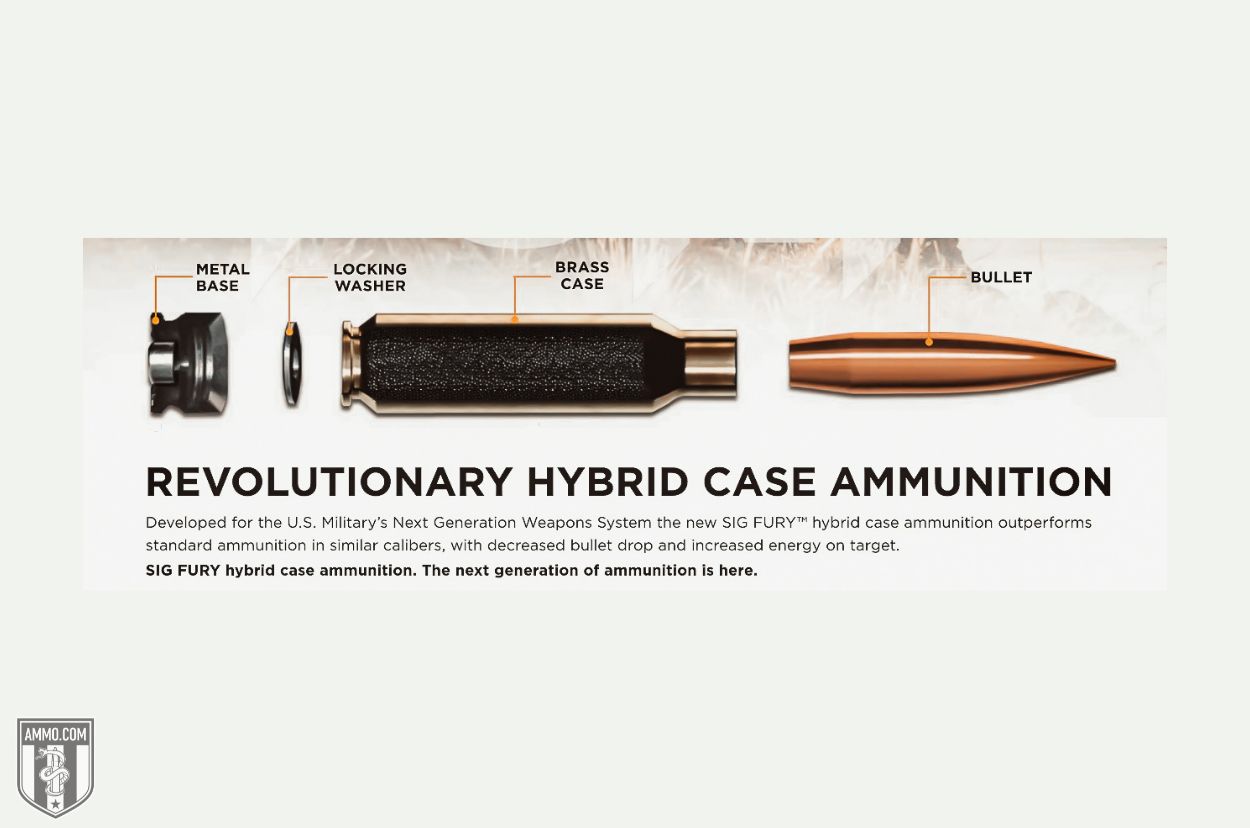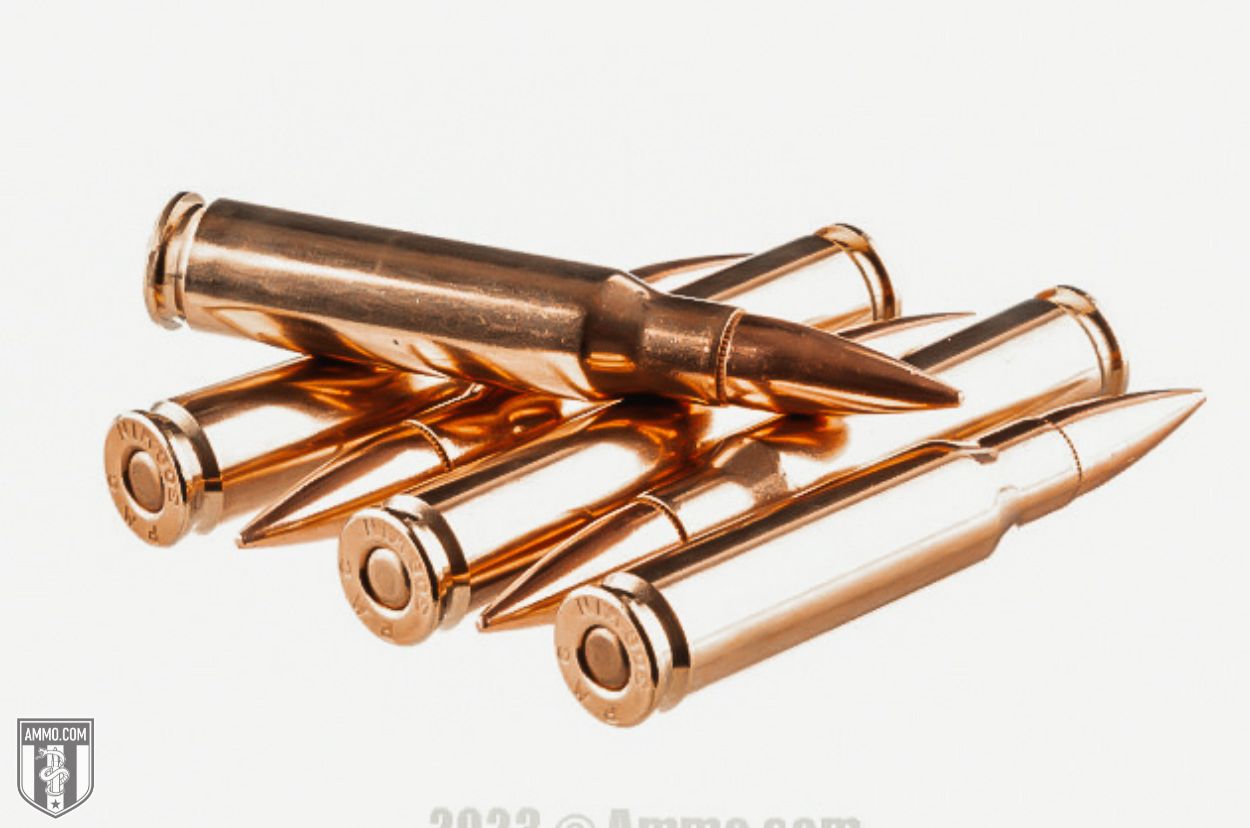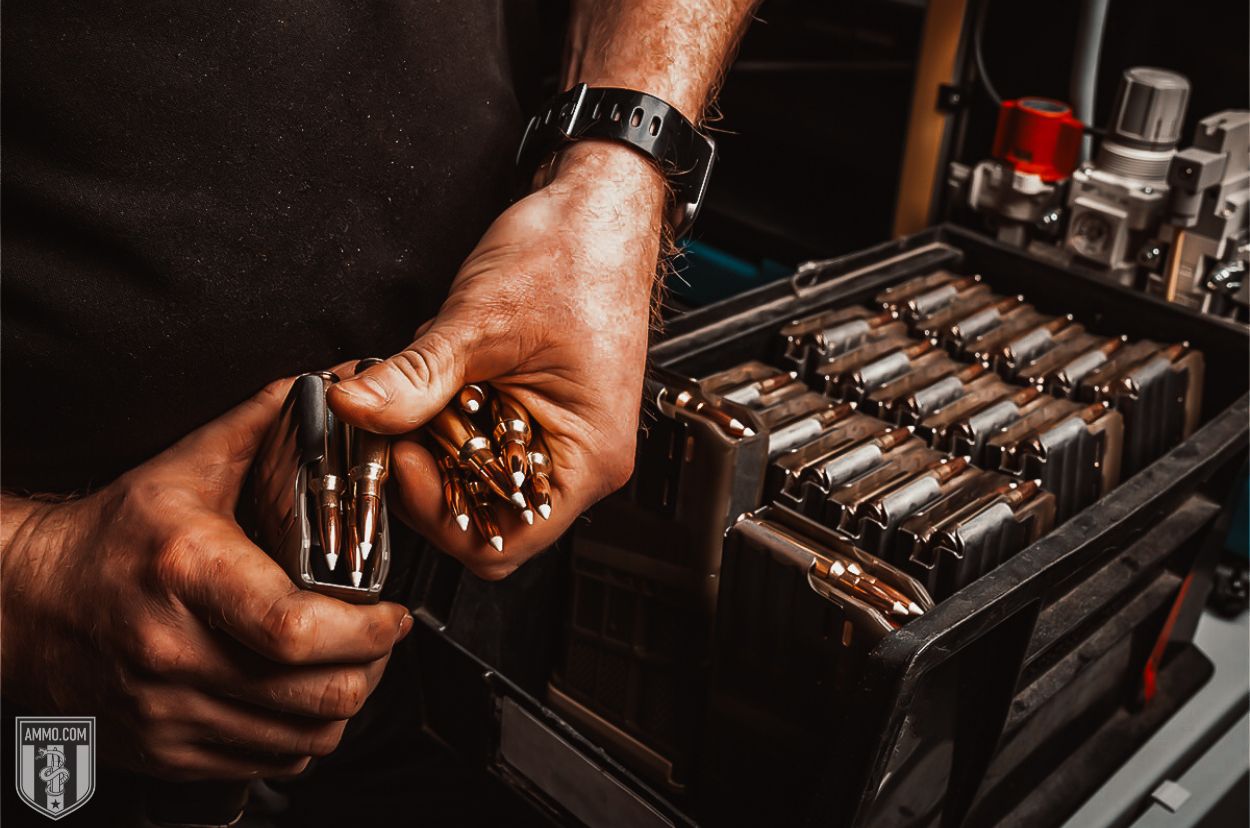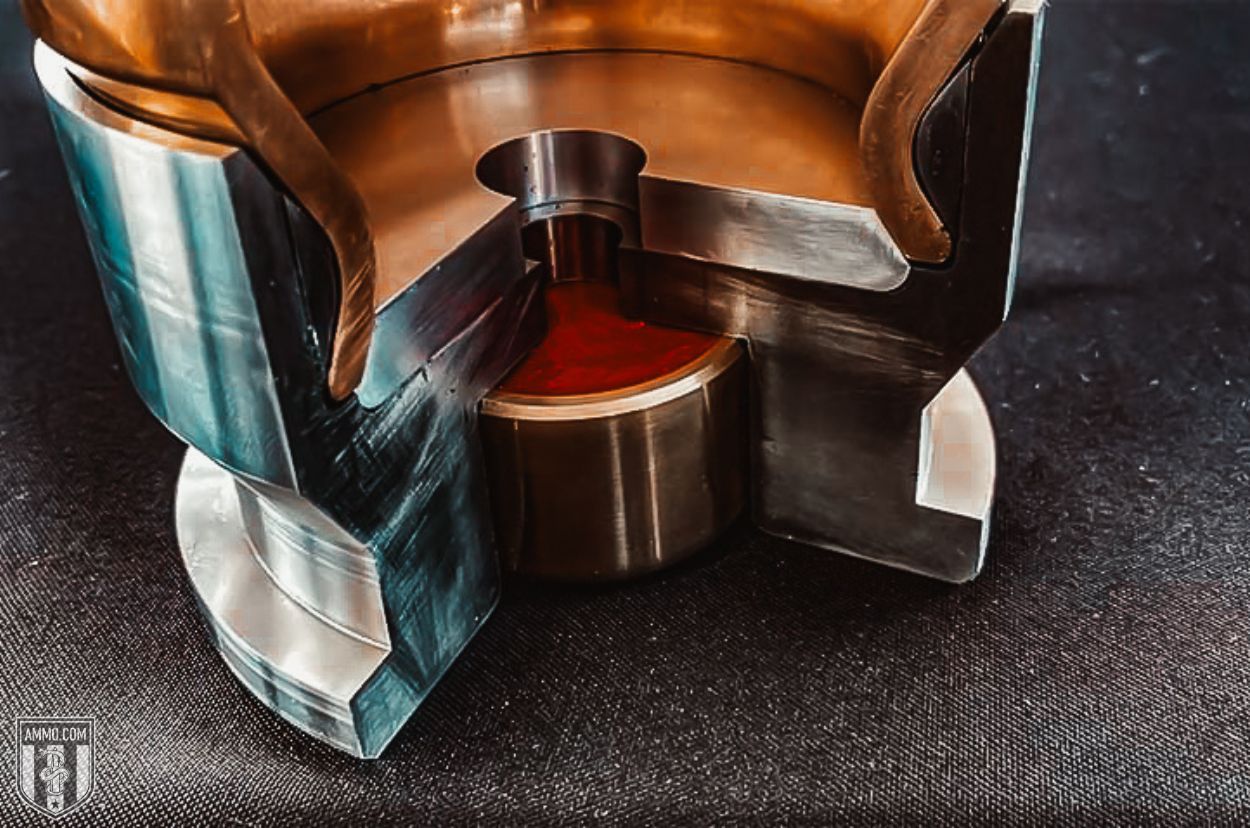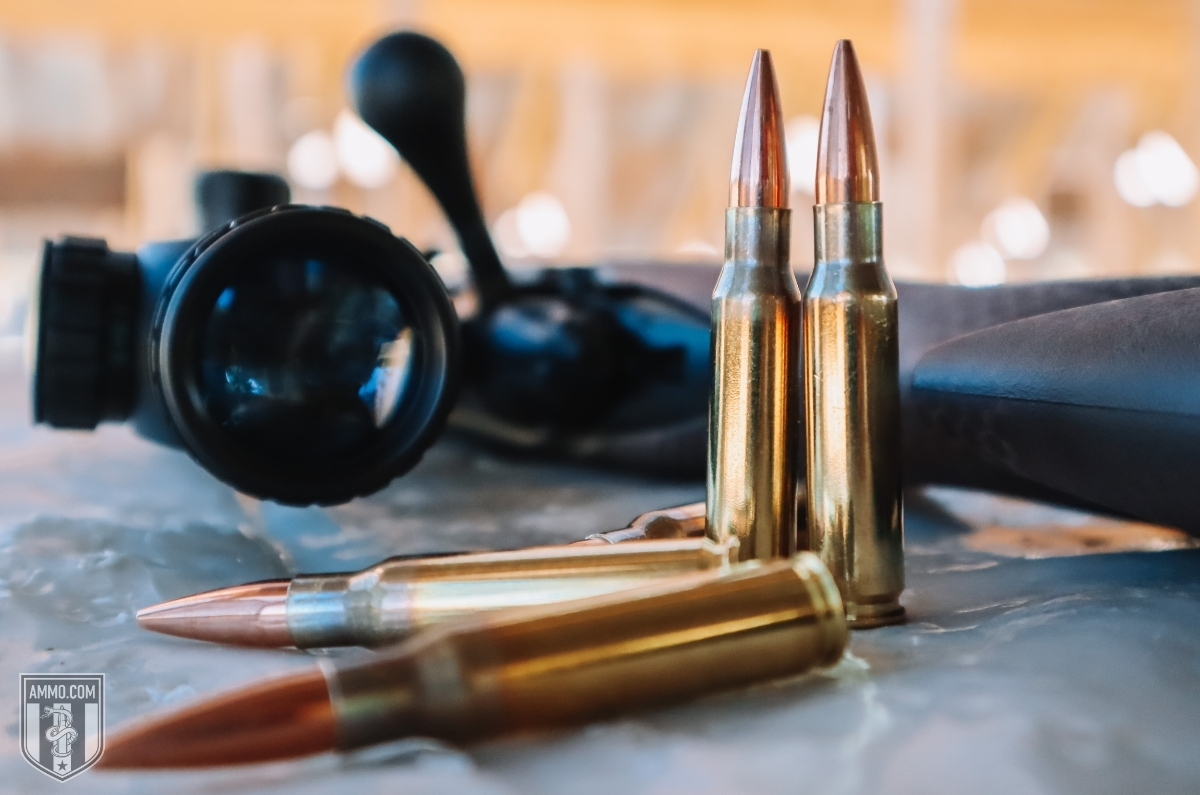277 Fury vs 308: Should the Army Go Back to the 308?
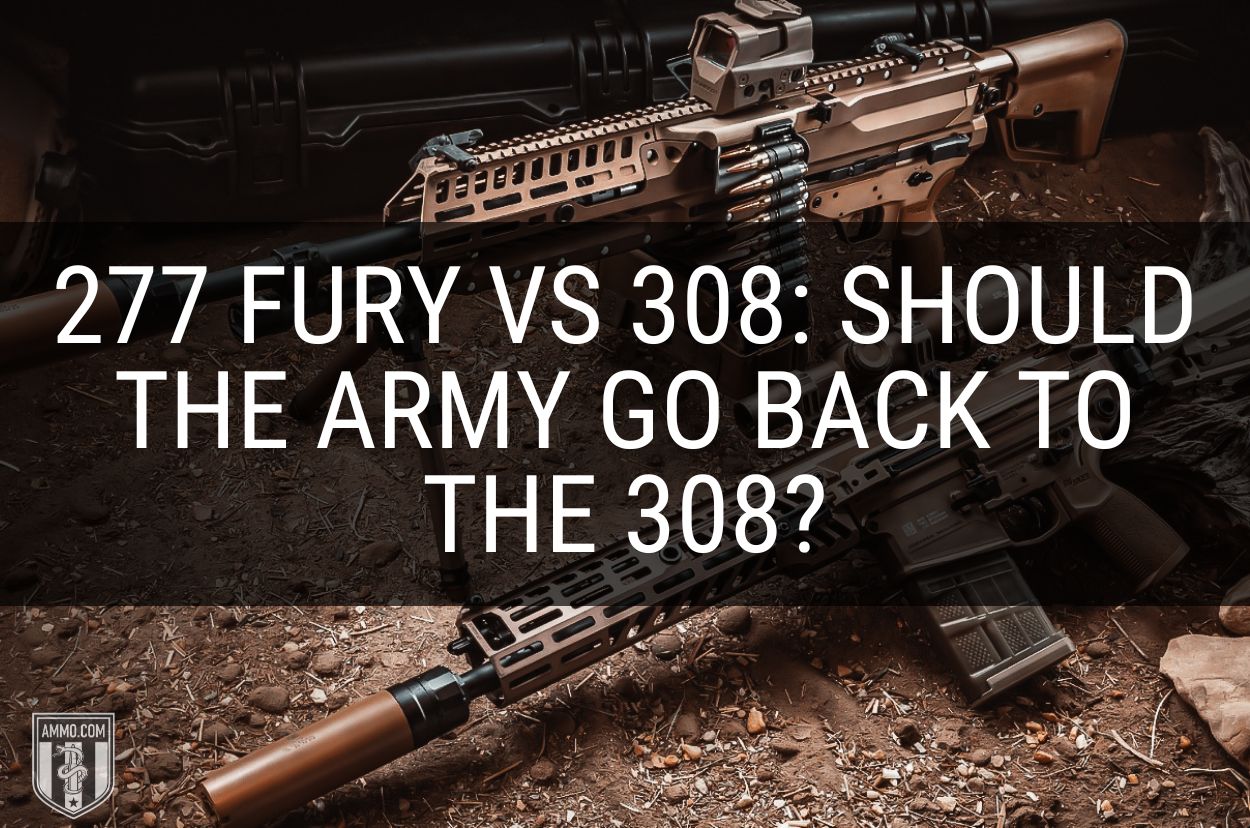
First Shots: 277 Fury vs 308
When the US Army announced that the SIG 277 Fury was the winner of the Next Generation Squad Weapon program (NGSW) contract in 2022, it took many American shooters by surprise (myself included).
I’ve got a lot of questions that I’d like to propose to top Army brass about this decision, but none are more prescient than this:
Why not just go back to 308 Winchester?
To be honest, it makes a lot of sense, as the 308 Win has served the U.S. Military for decades, offering soldiers long-range shooting capabilities and stopping power from both bolt-action rifles and belt-fed machine guns.
Although I’m not expecting to receive an email from the Army Chief of Staff anytime soon, let’s compare the 308 Winchester to the 277 Sig Fury to see which one is better for your shooting needs and see if the military made a mistake switching to a new cartridge.
What’s the Difference Between 277 Fury and 308?
The main difference between the 277 Fury and 308 Winchester is the caliber bullet they each fire as both cartridges have identical case lengths. The 308 Winchester fires a 0.308” diameter bullet, while the 277 Fury is designed to fire a 0.278” bullet diameter.
Cartridge Specs
When evaluating centerfire cartridges, it’s a good idea to analyze the cartridge specs to gain more knowledge of each.
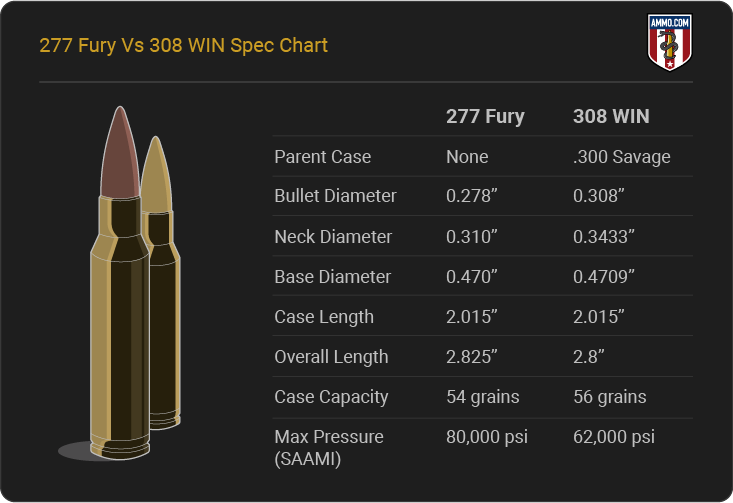
Obviously, both rounds fire different bullet diameters, with the 308 Winchester firing a 0.308” diameter bullet compared to a 0.278” for the 277 Fury. The Fury typically fires bullets between 125 grains and 150 grains, with 135 grains being the most popular. The 308 Win, on the other hand, can fire bullets as light as 110 grains all the way up to 220 grains.
But perhaps the biggest difference between these two cartridges is the design of the case itself.
The 308 Win has a traditional solid brass case, but the 277 Fury cartridge uses a 3-piece hybrid case design. Instead of being solid brass, the 277 Fury cartridge case consists of a stainless-steel case head (base), an aluminum locking washer, and a brass body.
According to Sig Sauer, the stainless-steel case head is required to handle the higher pressures their new cartridge produces. And they aren’t kidding, as the 277 Fury is rated up to 80,000 psi, which is the highest chamber pressure ever approved and certified by SAAMI. In comparison, the 308 Win is only rated up to 62,000 psi per SAAMI standards.
With all that pressure, it’s questionable how long the barrel life of the 277 Fury will be. However, there sadly is not enough data to know if the Furry cartridge is a barrel burner yet, given how young this rifle cartridge is.
Other than the differences in bullet diameter and maximum chamber pressure, the 277 Fury and 308 are eerily similar. Their case length is identical, base diameter is nearly the same, and the 308 only has 2 grains more case capacity than the 277 Fury.
Although the Furry cartridge is said to be a unique design, these similarities have led many to theorize that the 308 Winchester is the parent case for the 277 Fury.
All in all, the 277 Sig Fury and 308 Win are extremely similar in their case specs; let’s see how that translates in terms of recoil and external ballistics.
Recoil
Recoil is an important consideration when purchasing a new rifle, as a round with heavy recoil will be more difficult to control and will slow your rate of follow-up shots.
Recoil is affected primarily by muzzle velocity (FPS), powder charge, bullet weight, and rifle weight.
In general, the 277 Fury will have slightly less felt recoil than the 308 Winchester since it is firing lighter bullet weights at a higher velocity.
For a military-grade 277 Fury fired from a Sig Sauer MCX-Spear weighing 8.6 pounds, a 135-grain Hybrid Match bullet will have a free recoil of about 16.8 ft-lbs. On the other hand, a 308 Winchester 147 grain M80 FMJ military load will have a free recoil of 17.1 ft-lbs.
However, if you increase the bullet weight to a 175-grain M118 Long Range BTHP, the free recoil increases to 19.4 ft-lbs.
In general, the 277 Fury will have slightly less recoil than the 308 Win when comparing similar bullet weights. However, it’s unlikely all but the most recoil-sensitive shooters will be able to tell the difference between these two rifle cartridges.
Trajectory, Muzzle Velocity, and Kinetic Energy
Before you make the commitment to a caliber conversion, it’s a good idea to compare the ballistics of each rifle cartridge and understand their capabilities.
For this example, we will compare the muzzle velocity (fps), muzzle energy (ft-lbs), and trajectory (bullet drop) for four different factory loads.
For the 277 Sig Fury, we will consider the Elite Match Grade 135 grain FMJ and the Elite Bonded 150 grain Polymer Tipped manufactured by Sig Sauer. For the 308 Winchester, we will compare the Nosler 150-grain Expansion Tip and the Hornady Match 178-grain BTHP.
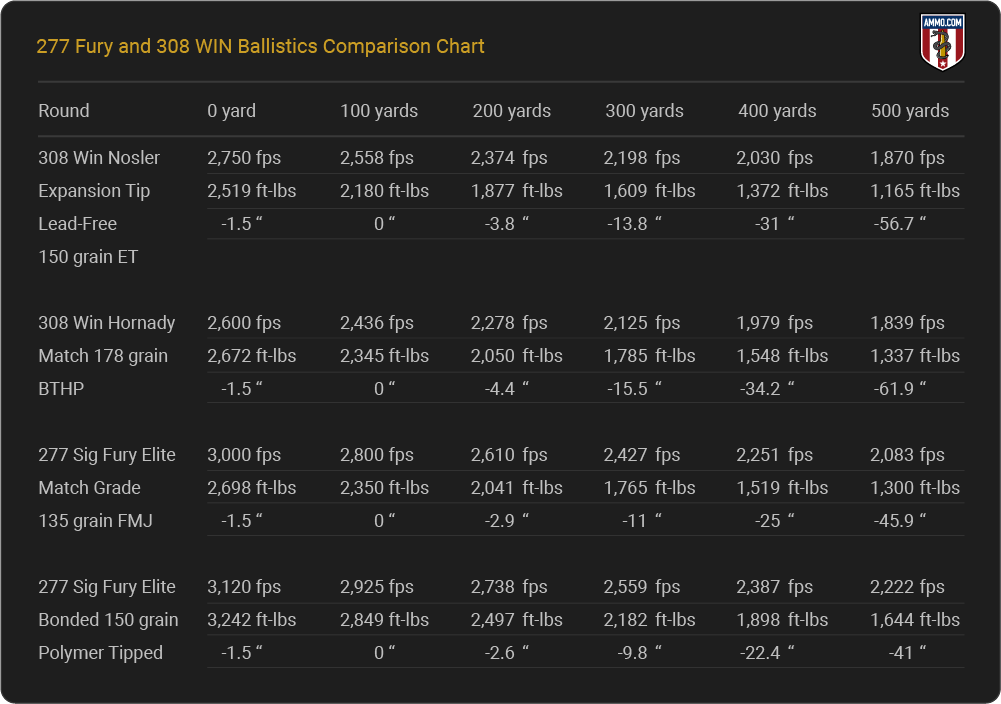
Looking at the ballistics table above, you can see that the 277 Fury surpasses the 308 Winchester in virtually every category. When comparing the two 150-grain loads, the 277 Fury has around 15% higher muzzle velocity and nearly 30% more muzzle energy. That’s impressive, considering both cartridges are virtually the same size.
In terms of bullet drop, the 277 Fury has a much flatter trajectory than the 308 Winchester by a wide margin. At 500 yards, the Sig Fury round has experienced a little over -40” of bullet drop compared to 56-60” of bullet drop for the 308 Winchester.
Sig Sauer advertises the 277 Fury as a long-range cartridge, and you can see why. According to Sig, the Fury has around 6 feet less bullet drop than a 6.5 Creedmoor (sometimes misspelled “Creedmore”) at 1,000 yards. And based on this ballistic data, I suspect their claims are correct.
It should be noted that the 150 gr Polymer Tip Fury round is the only factory load that Sig Sauer currently sells to civilians loaded in the high-pressure hybrid case. This is the reason this load outperforms even the 135-grain option, as the hybrid case can handle higher pressure than a traditional brass case, providing higher velocity and higher muzzle energy.
To summarize, the 277 Sig Fury cartridge outperforms the 308 Winchester in terms of ballistics at all ranges. The Fury provides shooters with a high velocity, flat shooting round that can easily reach out to 1,000 yards in the right hands.
Ballistic Coefficient and Sectional Density
Ballistic coefficient (BC) is a measure of how aerodynamic a bullet is and how well it will resist wind deflection. Sectional density (SD) is a way to evaluate the penetration ability of a bullet based on its external dimensions, design, and weight.
Typically, longer and heavier bullets will have a higher BC as they can resist wind drift more efficiently.
For this comparison, we will examine the 150-grain Nosler Accubond, a popular hunting round that is available in both calibers.
In terms of ballistic coefficient, when comparing both bullets side-by-side, the 277 Fury has a slight edge with a BC of 0.5 compared to 0.435 for the 308 Win. However, when you consider heavier 0.308” diameter bullets, such as the 168 grain and higher bullet weights, the 308 Winchester can close the gap or exceed the Fury, depending on the bullet design.
For penetration, both rounds are about equal, though the 277 has a slight edge at 0.279 compared to 0.226 for the 30-cal.
The design of the 0.278” diameter bullet lends itself to being more aerodynamic and penetrate deeper thanks to its long, slender design. The 0.308” bullet can keep pace with the 277 but requires heavier bullets to match the Fury’s ballistic performance.
Accuracy
Accuracy is extremely difficult to quantify when comparing two different rifle cartridges since accuracy is more a byproduct of the firearm being used and the shooter pulling the trigger.
Both rounds can be extremely accurate in well-trained hands, as both are capable of accurately reaching 1,000 yards with proper loads.
However, given the flatter trajectory of the 277 Fury, this round will lend itself to being more accurate at longer ranges thanks to its higher muzzle velocity.
Hunting
When it comes to big game hunting, the 308 Winchester remains the king of the woods and is in no danger of being supplanted by the 277 Fury.
I’m sure you might be scratching your head at this point, as I’ve been doing nothing but gushing about the ballistic performance of the 277 Sig Fury up to this point. But when it comes to hunting, the track record of the 308 Win is undeniable.
Since the 1950’s the 308 Winchester has been THE go-to caliber for hunting whitetail deer, feral hogs, elk, and black bear. And although the 277 Fury might offer better long-range ballistics, finding hunting ammo for the round is going to be extremely difficult (more on that later).
However, walk into any sporting goods store across America, and I can guarantee you that you’ll have a huge selection of 308 hunting ammo at your fingertips.
Self-Defense/Home Defense
Honestly, neither of these rounds is ideal for self-defense, given how powerful they are. Both rounds will likely over-penetrate through any would-be home invader (unless they are wearing body armor) and blast into your neighbor’s home or apartment.
However, if I had to pick one, it would be the 308 Winchester, as it is “less” likely to over-penetrate, and there are self-defense rounds available like the Winchester PDX-1 Defender 120 grain SCHP.
The 277 Fury will have no problem defending your life, but the 308 is the better choice if you can’t get to your home defense handgun.
Ammo and Rifle Cost/Availability
When it comes to ammo and rifle availability, the 308 Winchester is clearly the better option.
As the 308 Win has been the preferred big game hunting cartridge (alongside the 300 Win Mag) for decades, there are an insane number of rifles and ammo varieties available to you.
Virtually every ammo manufacturer has an offering in 308 Winchester, and this helps keep supply high and costs low.
For inexpensive plinking 308 ammo, you should expect to pay around $1/round at the time of writing. Cheap soft point hunting ammo can be had for a few dimes more, while premium hunting ammo or match-grade ammo typically runs around $1.60/round.
Rifles chambered in 308 Win are also extremely easy to find in a wide variety of barrel lengths and configurations. At the time of writing, you can easily pick up a budget bolt-action hunting rifle for around $500 or if you want a semi-auto rifle, you can expect to pay around a grand for an AR-10 or a used M1a.
If you plan to shoot 277 Fury, you’re going to need a deep ammo budget or have Uncle Sam paying for your ammo.
At the time of writing, the only firearm chambered in 277 Fury available to American shooters is the Sig Cross bolt-action rifle with a 16-inch barrel. Although this would make a lovely tricked out hunting rifle, it also will set you back about $2,000 or more, and that’s if you can find one. Sig says that they plan to release a new version of their semi-auto MCX-Spear chambered in 277 Fury, but as of December 2023, this has not happened.
Ammo is also extremely difficult to find as Sig Sauer is the only company currently manufacturing 277 Fury rounds. And they are pretty pricey, too, with plain-Jane FMJ rounds costing over $2/round, while hunting ammo will punch holes in your wallet to the tune of $4/round and up.
If the Sig Fury cartridge starts to become more popular, it’s likely that other ammo manufacturers will add the round to their roster and drive the price down some. However, if you want to shoot a lot and not break your budget, then the 308 Winchester is clearly the better choice.
Reloading
When it comes to reloading, the 308 Winchester has considerably more bullet, powder, and equipment options when compared to the 277 Fury.
As an avid handloader and having lived through numerous powder, primer, and bullet shortages, I understand the benefit of having variety on your reloading bench.
That being said, the 30-caliber bullet is one of America’s favorites, and you can easily find tons of different styles and profiles to meet all your reloading needs. There are plenty of bullets available for the 277 Fury, thanks to the 270 Winchester, but in general, 0.278” bullets are a little trickier to find.
However, the biggest issue I’m seeing is a lack of reloading equipment, brass, and load data for the 277 Fury at this time.
In terms of reloading dies, only Lee Precision and Forster currently have offerings for the Fury. For the 308 Win, basically, any company that manufactures reloading dies has a 308 option (Redding is my preference). The same thing goes for reloading data, as there are very few resources available for the Fury, while every reloading manual published today has load data for the 308 Win.
And let’s not even talk about brass. Good luck finding factory-new or once-fired 277 Fury brass out in the wild. Whereas 308 brass cases are extremely easy to find, virtually a dime a dozen (metaphorically speaking).
Although I suspect these issues will iron themselves out in time, as of Q4 2023, the 308 Winchester is the better choice if you plan to reload your own hunting, plinking, or target rounds.
277 Fury vs 308 Ballistics
Below, you’ll find our ballistics tables for multiple factory loads for 308 Winchester and SIG 277 Fury. This data is for reference only, and actual ballistic performance can vary depending on barrel length, load, and other shooting conditions.
277 Fury Ballistics
Note: This information comes from the manufacturer and is for informational purposes only. The actual ballistics obtained with your firearm can vary considerably from the advertised ballistics. Also, ballistics can vary from lot to lot with the same brand and type load.

308 Ballistics
Note: This information comes from the manufacturer and is for informational purposes only. The actual ballistics obtained with your firearm can vary considerably from the advertised ballistics. Also, ballistics can vary from lot to lot with the same brand and type load.
| 308 Winchester Bullet WEIGHT | Muzzle VELOCITY (fps) | Muzzle ENERGY (ft. lbs.) | TRAJECTORY (in.) | |||||||||||
|---|---|---|---|---|---|---|---|---|---|---|---|---|---|---|
| Muzzle | 100 yds. | 200 yds. | 300 yds. | 400 yds. | Muzzle | 100 yds. | 200 yds. | 300 yds. | 400 yds. | 100 yds. | 200 yds. | 300 yds. | 400 yds. | |
| 55 Grain | 3770 | 3215 | 2726 | 2286 | 1888 | 1735 | 1262 | 907 | 638 | 435 | -2 | 1.4 | -3.8 | -15.8 |
| 110 Grain | 3165 | 2830 | 2520 | 2230 | 1960 | 2447 | 1956 | 1551 | 1215 | 938 | 1.4 | 0 | -6.9 | -20.9 |
| 120 Grain | 2850 | 2497 | 2171 | n/a | n/a | 2164 | 1662 | 1256 | n/a | n/a | 0 | -2.8 | n/a | n/a |
| 150 Grain | 2820 | 2533 | 2263 | 2009 | 1774 | 2648 | 2137 | 1705 | 1344 | 1048 | 2.5 | 0.4 | -8.5 | -26.1 |
| 150 Grain Superformance | 3000 | 2772 | 2555 | 2348 | 1962 | 2997 | 2558 | 2173 | 1836 | 1540 | 1.5 | 0 | -6.9 | -20 |
| 155 Grain | 2775 | 2553 | 2342 | 2141 | 1950 | 2650 | 2243 | 1887 | 1577 | 1308 | 1.9 | 0 | -8.3 | -24.2 |
| 155 Grain | 2850 | 2640 | 2438 | 2247 | 2064 | 2795 | 2398 | 2047 | 1737 | 1466 | 1.8 | 0 | -7.5 | -22.1 |
| 165 Grain | 2700 | 2440 | 2194 | 1963 | 1748 | 2670 | 2180 | 1763 | 1411 | 1199 | 2.5 | 0 | -9.7 | -28.5 |
| 168 Grain | 2680 | 2493 | 2314 | 2143 | 1979 | 2678 | 2318 | 1998 | 1713 | 1460 | 2.5 | 0 | -8.9 | -25.3 |
| 168 Grain Super Match | 2870 | 2647 | 2462 | 2284 | 2114 | 3008 | 2613 | 2261 | 1946 | 1667 | 1.7 | 0 | -7.5 | -21.6 |
| 170 Grain | 2000 | 1740 | 1510 | n/a | n/a | 1510 | 1145 | 860 | n/a | n/a | 0 | 0 | 0 | 0 |
| 178 Grain | 2620 | 2415 | 2220 | 2034 | 1857 | 2713 | 2306 | 1948 | 1635 | 1363 | 2.5 | 0 | -9.6 | -27.6 |
| 178 Grain Super Match | 2780 | 2609 | 2444 | 2285 | 2132 | 3054 | 2690 | 2361 | 2064 | 1797 | 1.8 | 0 | -7.6 | -21.9 |
| 180 Grain | 2620 | 2393 | 2178 | 1974 | 1782 | 2743 | 2288 | 1896 | 1557 | 1269 | 2.5 | -0.2 | -10.2 | -28.5 |
277 Fury Development/History
The stopping power of the 5.56 NATO has been a heated talking point in the American shooting community ever since the Battle of Mogadishu. Numerous small arms manufacturers have tried to replace the 5.56, but none have been successful until Sig Sauer did it in 2022.
Rounds like the 6.8 SPC, 6.5 Grendel, and 300 Blackout all fell short, but these rounds were designed to fit in the AR-15/M4 Carbine, while the 277 Fury took a different approach.
Designed for the Next Generation Squad Weapon (NGSW) program, Sig Sauer looked to replace the M4 Carbine, M249 SAW, and M240 machine gun with their new XM5 and XM250 LMG (Light Machine Gun).
Chambered in the new Sig 277 Fury, the new round can fire with or without a suppressor and is designed to penetrate modern body armor out to 500 meters.
Although military trials are still ongoing circa December 2023, the new 277 Sig Fury offers American soldiers enhanced long-range capabilities, stopping power, and armor penetration, making a strong case to replace the 5.56 NATO.
308 Development/History
After the Korean War, the US Army started developing a new round to replace the aging 30-06 Springfield and the M1 Garand.
What they came up with was the 308 Winchester or 7.62x51mm NATO that fit into a short action and had similar ballistics to the 30-06. The new 308 Win came chambered in the Army’s new battle rifle, the M14, but was replaced in a few years by the new M16 and 223 Remington intermediate cartridge.
Although the 308 Winchester has not been the main battle rifle cartridge for the US military for decades, it has continued service in multiple machine guns as well as precision bolt-action rifles for snipers.
However, the main success of the 308 Win came with civilian shooters and hunters, who loved the flexibility of the new cartridge and were quick to exchange their heavy long-action 30-06 rifles for lighter, more maneuverable short-action hunting rifles.
Since then, the 308 Winchester has been one of the go-to big game hunting cartridges for many shooters, and it’s unlikely that the American shooting community will give up its beloved 30-cal anytime soon. Hunters love the long-range capability offered by their 308 rifles; ammo is inexpensive, and the 308 has considerably less recoil than heavier cartridges like the 300 Win Mag or 338 Lapua.
To read more about the 308, check out the full history of the cartridge on our 308 history page.
Parting Shots: 308 Win vs 277 Fury
So, did the Army make a mistake in selecting the new 277 Fury instead of the classic 308 Win? Probably not.
The 277 Sig Fury offers soldiers enhanced capabilities and utilizes new technologies to push the envelope in terms of ballistics and terminal performance in ways the 308 simply cannot keep up with.
It’s an innovative design that allows American soldiers to carry one common caliber for both their battle rifles and machine guns, giving them a longer effective range with increased stopping power.
For most civilian shooters, going with the 308 Winchester is the logical choice, thanks to extremely high ammo availability and a lower overall cost. To get even better deals, visit our 308 bulk ammo page and save on your next purchase.
However, if the military fully embraces the 277 Fury, we could see more manufacturers step in to provide the shooting community with more ammo options for the Fury, making it a more practical round for the average shooter sometime in the near future.
Ammo Comparisons
- .308 vs 5.56
- 6.5 Creedmoor vs .308
- .300 Blackout vs .308
- .300 Win Mag vs .308
- .243 vs .308
- .308 vs .30-06
- 7mm-08 vs .308
- .270 vs .308
- 7.62x39 vs .308
- .223 vs .308
- .338 Lapua vs .308
- .380 ACP vs 9mm
- .223 vs 5.56
- .300 Blackout vs 5.56
- 9mm vs 45 ACP
- 9mm vs 40 S&W
- .357 SIG vs 9mm
- 10mm vs 9mm
- 9mm vs 9mm Luger
- .243 vs .270
- .300 Win Mag vs .30-06
- .270 vs .30-06
- .40 vs .45
- 38 Special vs 357
- 9mm vs 40 vs 45
- 5.56 vs 7.62x39
- 338 Lapua vs .30-06
- .30-30 vs .30-06
- 300 PRC vs 338 Lapua
- .30-06 vs 7mm
- 300 Win Mag vs 338 Lapua
- 300 PRC vs 300 Win Mag
- 300 WSM vs 300 Win Mag
- 338 Win Mag vs 338 Lapua
- 12 Gauge vs 20 Gauge
- 10mm vs 357 Mag
- .30-30 vs 7.62x39
- 224 Valkyrie vs 22-250
- 17 HMR vs 22 Mag
- 7.62x39 vs .300 Blackout
- 45 ACP vs 45 Auto
- 45-70 vs 30-30
- 300 Blackout vs 223
- 357 Magnum vs 9mm
- 350 Legend vs 300 Blackout
- 224 Valkyrie vs 223
- 45 ACP vs 38 Super
- 6.5 Grendel vs .308
- 17 HMR vs 22 LR
- 10 Gauge vs 12 Gauge
- 22-250 vs 223
- 45 Colt vs 45 ACP
- 350 Legend vs 30-30
- 5.7x28 vs 223
- 5.7 vs 9mm
- 5.56 vs 5.7
- 22 vs 9mm
- Buckshot vs Birdshot
- 450 Bushmaster vs 308
- 450 Bushmaster vs 223
- Buckshot vs Slug
- 6.5 Grendel vs 5.56 vs 223
- 6mm ARC vs 6.5 Grendel
- 44 vs 45
- 458 SOCOM vs 5.56
- 357 vs 44
- 32 ACP vs 380
- 300 Win Mag vs 338 Win Mag vs 338 Lapua Mag
- 450 Bushmaster vs 458 SOCOM vs 50 Beowulf
- 6mm Creedmoor vs 6.5 Creedmoor
- TMJ vs FMJ
- 44 Special Vs 44 Magnum
- 45 90 vs 45 70
- 6.8 Western vs 6.8 SPC
- 50 Beowulf vs 50 BMG
- 26 Nosler vs 6.5 PRC
- 28 Gauge vs 410
- 6.8 SPC vs 5.56
- 6.8 SPC vs 6.5 Grendel
- 6.8 Western vs 7mm Rem Mag vs .28 Nosler
- 6.8 Western vs 6.5 Creedmoor
- 22 Hornet vs 223
- 6.8 Western vs 6.5 PRC
- .410 vs 12 Gauge
- .410 vs 20 Gauge
- 22 LR vs 22 Mag
- 6mm ARC vs 243
- 7mm-08 vs 270
- 243 vs 6.5 Creedmoor
- Nickel vs Brass Casing
- 204 Ruger vs 223
- 50 Beowulf vs 5.56
- 260 Remington vs 6.5 Creedmoor
- 6mm Remington vs 243
- 28 Nosler vs 300 PRC
- 50 Beowulf vs 50 AE
- 22 Nosler vs 22-250
- 450 Marlin vs 45-70
- 300 Win Mag vs 300 Norma
- 458 SOCOM vs 300 Blackout
- 38-55 vs 45-70
- 22 Hornet vs 22 LR
- 300 Norma vs 338 Lapua
- 338 Lapua vs 50 BMG
- 28 Nosler vs 300 Win Mag
- 28 Nosler vs 6.5 Creedmoor
- 204 vs 22-250
- 458 SOCOM vs 45 70
- 44 40 vs 45 70
- 6.8 SPC vs 6.5 Creedmoor
- 450 Bushmaster vs 30-06
- 7mm Rem Mag vs 300 Win Mag
- 30 Carbine vs 223
- 25-06 vs 30-06
- 26 Nosler vs 28 Nosler
- 16ga vs 12ga
- 30 06 vs 7.62 x54R
- 9mm Makarov vs 9mm Luger
- 350 Legend vs 223
- 30 Carbine vs 5.56
- 6.5x55 vs 6.5 Creedmoor
- 6.5 Creedmoor vs 270 vs 25-06
- M193 vs M855
- 450 Bushmaster vs 458 SOCOM
- 6.5 Grendel vs 6.5 Creedmoor
- 350 Legend vs 5.56
- .277 Fury vs 6.8 SPC
- 277 Fury vs 300 Win Mag
- 10mm vs .45 ACP
- 277 Fury vs 223
- 6.8 SPC vs 300 Blackout
- 6.5 PRC vs 6.5 Creedmoor
- 277 Fury vs 308
- 277 Fury vs 6.5 Creedmoor
- 350 Legend vs 450 Bushmaster
- 277 Fury Vs 5.56 NATO
- 10mm vs 40S&W
- 32 ACP vs 9mm
- 32 Special vs 9mm
- 8.6 Blackout vs 300 Blackout
- 30 Super Carry vs. 9mm
- 5.56 vs 9mm
- .50 Action Express vs 9mm
- 7.62x25 vs. 9mm
- 10mm vs 44 Magnum
- 300 Blackout vs 300 Win Mag
- 6.5 Grendel vs 300 Blackout
- 460 Rowland vs 10mm
- 300 RUM vs 300 PRC
- 300 Norma vs 300 PRC
- 45 GAP vs 45 ACP
- 7mm PRC vs 300 Win Mag
- 300 PRC vs 6.5 Creedmoor
- 300 PRC vs 308
- 357 SIG vs 357 Mag
- 7.62x39 vs 7.62x51
- 243 Win vs 223 Rem
- 30 Nosler vs 300 PRC
- 6.5 Creedmoor vs. 30-06 Springfield
- 450 S&W vs. 44 Magnum
- 6.5 Creedmoor vs. 300 Win Mag
- 454 Cassull vs. 45-70 Govt
- 454 Cassull vs. 44 Mag
- 7.62x54r vs. 308 Winchester
- 22 ARC vs. 223 Rem
- Subsonic vs. Supersonic Ammo
